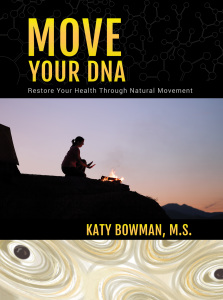Katy Bowman, MS: Master Your Body for Better Performance, And Movements (Not Exercise) that Every Endurance Athlete Needs
December 17, 2014Find out more at enduranceplanet.com/skora.
#runreal
 Katy Bowman, MS, is a biomechanist and author who’s helped thousands reduce chronic pain, increase bone density, and improve metabolic health through movement and proper alignment. Now she takes on endurance athletes in this podcast!
Katy Bowman, MS, is a biomechanist and author who’s helped thousands reduce chronic pain, increase bone density, and improve metabolic health through movement and proper alignment. Now she takes on endurance athletes in this podcast!
Katy writes frequently on her blog, KatySays.com, and has several published books including her most recent (and the focus of this show) titled, Move Your DNA: Restore Your Health Through Natural Movement.
Her other books include, Every Woman’s Guide to Foot Pain Relief: The New Science of Healthy Feet and Alignment Matters: The First Five Years of Katy Says.
On this show & in her latest book you’ll find out more on the following:
Intro
-The premise of Move your DNA – what does that mean?
-Katy’s history as a chronic exerciser but why and how she was not “healthy” – i.e. she had acne, body hurt, she’d get anxiety if she didn’t exercise, cramps, not that lean, not that strong – and the takeaway she learned
Movement issues
-What is movement, why is it the answer and HOW is it different than exercise?
-Goal of movement vs. exercise? For athletes?
-Standing work station – pros and cons
-circulatory system & cardio issues – why being sedentary with random exercise is the worst for our heart = working over time. But movement keeps blood moving all around
-How our body adapts to poor form/bad habits
Major common issues in modern humans
-duck feet
-shoulders/posture/kyphosis
-chronically flexed knees and hip flexors
-hips & pelvis (pelvis stabilization!!!)
Running
-the idea of falling forward when walking – explain and is this also a bad concept to follow when running?
-Why is treadmill running is not like real running, biomechanically speaking
-How do you know if you’re in need of help even if you’re not injured?
Signs:
-painful massages — omg I can relate to this and after fixing myself, they no longer hurt like they once did!!
-test for hip abductor & extension tests for weaknesses (and other tests you present)
-other tests you’d recommend for athletes
Take steps to improve yourself & DNA
-Katy’s top movements that every athlete/person should be doing daily to overcome the bad habits we’ve developed (and for athletes to avoid biomechanical-related injuries), such as the exercises presented later in your book.
Comments (2)
Love this show, Katy’s a genius. Really changed my thinking on my exercise regime. Please get her back as soon as you can. Kudos.
She is a must have on the show again! A possible regular segment kind of awesome.